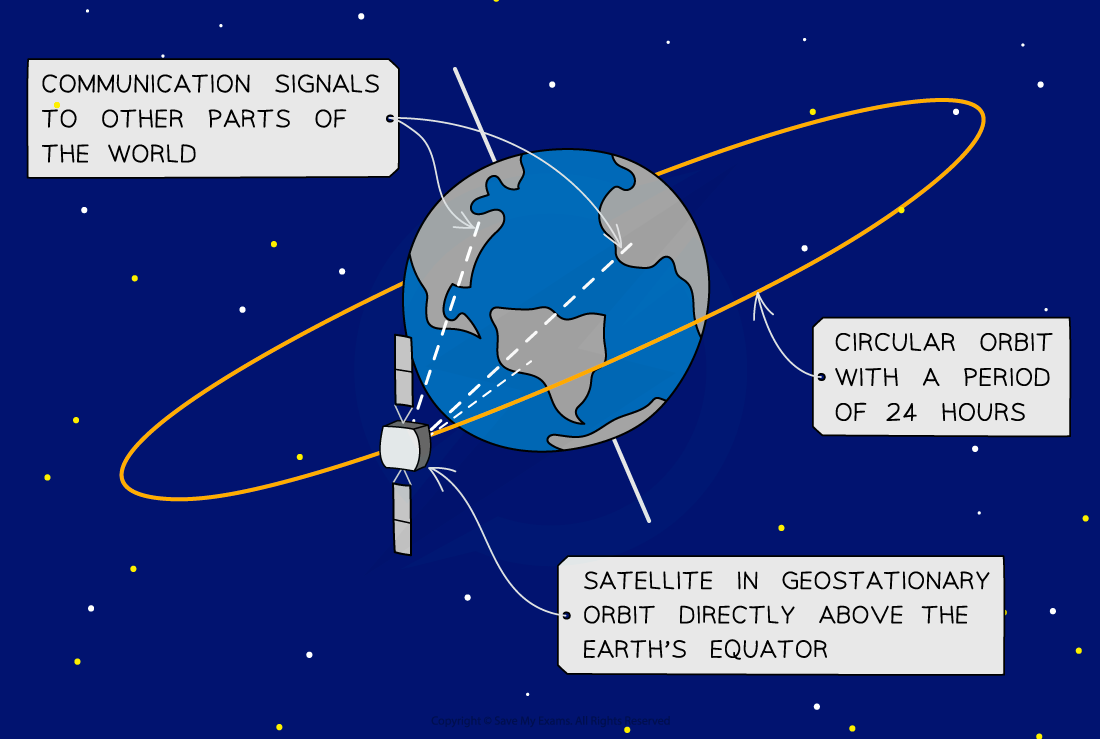Geostationary Orbits (AQA A Level Physics): Revision Note
Exam code: 7408
Synchronous Orbits
A synchronous orbit is:
When an orbiting body has a time period equal to that of the body being orbited and in the same direction of rotation as that body
These usually refer to satellites (the orbiting body) around planets (the body being orbited)
The orbit of a synchronous satellite can be above any point on the planet's surface and in any plane
When the plane of the orbit is directly above the equator, it is known as a geosynchronous orbit
Geostationary Orbits
Geostationary Orbit
Many communication satellites around Earth follow a geostationary orbit
This is a specific type of orbit in which the satellite:
remains directly above the equator
is in the plane of the equator
always orbits at the same point above the Earth’s surface
moves from west to east (same direction as the Earth spins)
has an orbital period equal to Earth’s rotational period of 24 hours
A geostationary orbit is a special case of a geosynchronous orbit
All geosynchronous orbits have an orbital period of 24 hours, but they do not necessarily orbit in the plane of the equator
Geostationary satellites are used for telecommunication transmissions (e.g. radio) and television broadcasts
A base station on Earth sends the TV signal up to the satellite, where it is amplified and broadcast back to the ground to the desired locations
The satellite receiver dishes on the surface must point towards the same point in the sky
Since the geostationary orbits of the satellites are fixed, the receiver dishes can be fixed too
Low Orbits
Some satellites are in low orbits, which means their altitude is closer to the Earth's surface
One example of this is a polar orbit, where the satellite orbits around the north and south poles of the Earth
Low orbits are useful for taking high-quality photographs of the Earth's surface. This could be used for:
Weather
Military applications

Geostationary satellite in orbit
Worked Example
The table gives data for two types of satellite, a low-Earth orbit (LEO) and a geostationary orbit
Orbit type | T / min | h / km |
LEO | 89 | 250 |
Geostationary | X | Y |
For the geostationary orbit, calculate
(i) the orbital period X in minutes.
(ii) the height Y above the Earth's surface that a geostationary satellite will orbit in km.
Answer:
Part (i)
Step 1: Convert the time period from seconds to minutes
The period of a geostationary orbit is X = 24 hrs
The period of a geostationary orbit is X = 24 × 60 = 1440 minutes
Part (ii)
Step 1: List the known quantities
Period of the LEO, TL = 89 min
Period of a geostationary orbit, TG = 1440 min
Height above Earth of the LEO, hL = 250 km
Radius of the Earth, R = 6.37 × 106 m (from the data sheet)
Step 2: Recall the relationship between orbital period and radius
Orbital period T is related to the radius r of the orbit by
Step 3: Convert the proportional relationship into an equation
Step 4: Evaluate a final value for Y
Orbital radius of LEO:
Orbital radius of geostationary:
Height above the Earth's surface:
Y =
Height above the Earth's surface: Y = 36 000 km
Examiner Tips and Tricks
Make sure to memorise the key features of a geostationary orbit, since this is a common exam question. Remember:
Equatorial orbit
Moves west to east
Period of 24 hours
You will also be expected to remember that the time period of the orbit is 24 hours for calculations on a geostationary satellite.

You've read 0 of your 5 free revision notes this week
Unlock more, it's free!
Did this page help you?